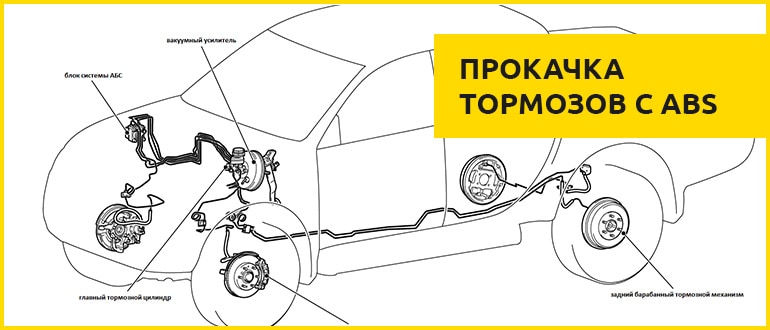
How to bleed ABS brakes
Content
Bleeding ABS brakes is no more difficult than bleeding a traditional car brake system. But in order to correctly remove air from the brake system on which the ABS system is installed, it is recommended to understand the principle and scheme of its operation specifically for your car. Since depending on the model, the pumping scheme may vary slightly. For example, when a hydraulic valve block and a hydraulic accumulator with a pump are in the same unit, both fluid replacement and bleeding of the brake system with ABS will be carried out in a similar way as bleeding brakes without ABS.
Types of ABS systems
- ABS includes: a block of hydraulic valves, a hydraulic accumulator, a pump (pumped in a garage);
- The pump, hydraulic accumulator and hydraulic valve block are separated into different units, such a brake system, in addition to the ABS module, also includes additional ESP, SBC modules (it is pumped in service stations). you need to have a diagnostic scanner in order to control the modulator valves.
Based on the features, we can conclude that before you bleed the brakes with ABS, decide on the type of your system, since this instruction will relevant only for standard anti-lock braking system.
The process of bleeding ABS brakes
In order to carry out the task with high quality, it is desirable to bleed with an assistant, starting to bleed the brake system from the front wheels, then the rear wheels (right and left).
The pressure is relieved by discharging the pressure accumulator. To do this, turn off the ignition and press the brake pedal about 20 times. And then to go to the next stage of bleeding the brake, disconnect the connectors on the brake fluid reservoir.
General principle of how to bleed ABS brakes
- We find and remove the fuse in the block responsible for the operation of the ABS;
- We unscrew the wheel and find the RTC fitting for pumping the brake;
- We begin to pump the brakes from the abs with the pedal depressed;
- We turn on the hydraulic pump (turning on the ignition, the ABS light on the dashboard will light up) and wait until all the air has come out;
- We twist the fitting and release the brake pedal, if the ABS light is no longer on, everything is done correctly and the air is completely out.
The sequence of air removal from the vehicle
We start pumping the brakes from the front rightand then the left one. Procedure occurs when the ignition is off (position on "0") and the removed terminal on the TZh tank.
- We put the hose, with a bottle, on the fitting and open it (with an open-end wrench). Needs to be worn transparent hose, in order for air bubbles to be visible, as well as the other end of the hose must be completely immersed in liquid.
- Fully depress the pedal and hold until all the air comes out.
- Tighten the union and release the pedal as the liquid flows without air.
Rear wheels are pumped with ignition on at key position "2".
- As in the case of bleeding the front wheels, we put the hose on the bleed fitting on the caliper.
- Having fully depressed the pedal, turn the ignition key (in order to start the hydraulic pump). We observe the air outlet and control the level of brake fluid in the reservoir (top up periodically).in order for the pump not to fail, you need to constantly monitor the level of TJ (in order to prevent running “dry”). And also do not allow to work continuously for more than 2 minutes.
- We close the fitting after the complete exit of air bubbles, and the pump is turned off and the brake is released.
in order to correctly bleed the brakes with abs on the rear left wheel, the sequence of actions needs to be slightly changed.
- As in previous cases, first we put the hose on the fitting and unscrew it not completely, but only 1 turn, and the pedal no need to squeeze.
- Turn the ignition key to start the hydraulic pump.
- As soon as the air is out squeeze the brake pedal halfway and twist the pumping union.
- Then we release the brake and wait for the pump to stop.
- Turn off the ignition and connect the removed connector from the tank.
If you need to bleed the brakes together with the ABS modulator, then information on this procedure can be found here.
Without fail, after the brakes have been pumped, before leaving, you need to check the tightness of the system and the absence of leaks. Check the brake fluid level.